Whether you're looking to renovate your kitchen or you're making a list of must-have items for your new home purchase, there are so many decisions! Trying to find the difference between a breakfast bar and a kitchen island can be a challenge in itself. Then you have to decide which one is right for you. Breakfast bars and kitchen islands look very similar, and many of their functions are the same. Because of this, these decisions can be a bit of a struggle. We've gathered some useful information that should help you as you work through this process!
Deciding which one of these features is better than the other depends on what you are looking for. The primary difference between a kitchen island and a breakfast bar is the main functionality:
- A kitchen island is made of a cabinet base topped with workable countertop space that is not connected to any other part of the kitchen, making it completely freestanding.
- A breakfast bar is like a kitchen island that offers 8 to 15 inches of countertop overhang off the base cabinets' sides, creating room for people to be seated comfortably.
There are many ways to incorporate a breakfast bar, a kitchen island, or both into your kitchen. However, there are also a few things to consider. Each of these features, though similar, will meet a slightly different need. Read on to understand which would be best for you.
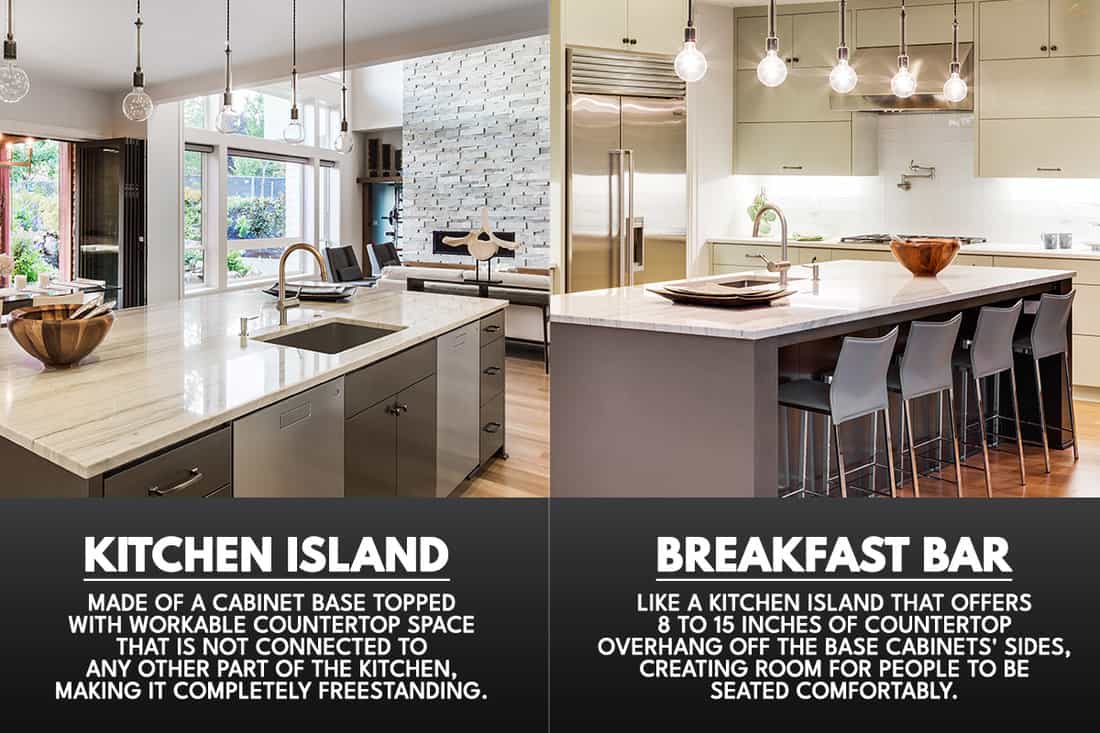
Kitchen Island
Kitchen islands come in all shapes and sizes. They can come built-in, or you can buy islands (or carts) to use in place of a built-in island.
Kitchen islands generally have a base made of cabinets. For built-in islands, the base cabinets usually match the surrounding cabinets or fit into the kitchen design. On top of the base, there is a workable countertop. This countertop will either end flush with the cabinet base or extend to a minimal overhang for aesthetic appeal.
You can find many clever features in build-in islands, such as a wet bar, wine fridge, cutting board, garbage drawer, stovetop, power outlets, and custom storage designs, to name a few.
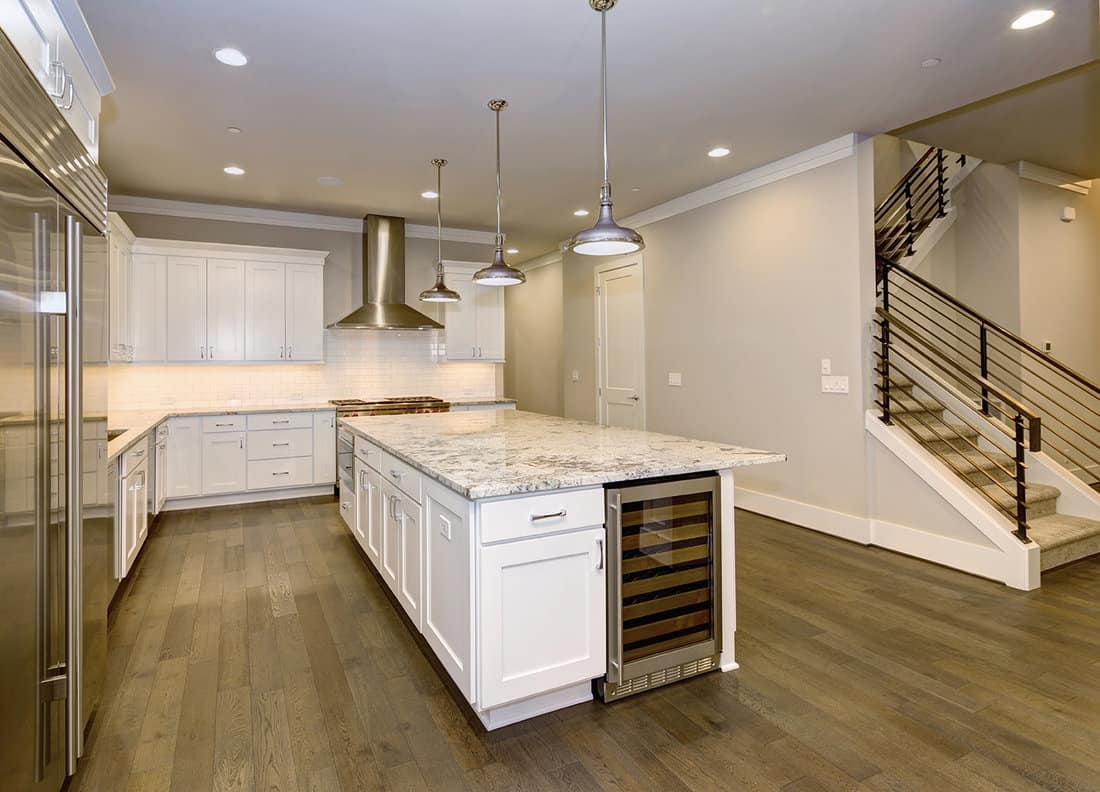
We may include affiliate links and curated AI content to highlight top design styles.
Store-bought kitchen islands will also have a base made of cabinets, but they are a pre-made design. There is less customization ability with store-bought, but they are a great solution for some benefits when built-in is not an option.
Click here to see this kitchen island on Amazon!
These island spaces can offer exceptionally wonderful mobility around your kitchen when they are placed properly and in the correct size. Because of the intentional design, islands are placed in areas where you can access many of the necessary points, such as your stove, fridge, and sink, all while being able to extend your working space while you're preparing meals.
Islands also give the ability to store some of your commonly used kitchen appliances in easy-to-reach locations. This is an advantageous benefit if you are one who loves being in the kitchen.
Breakfast Bar
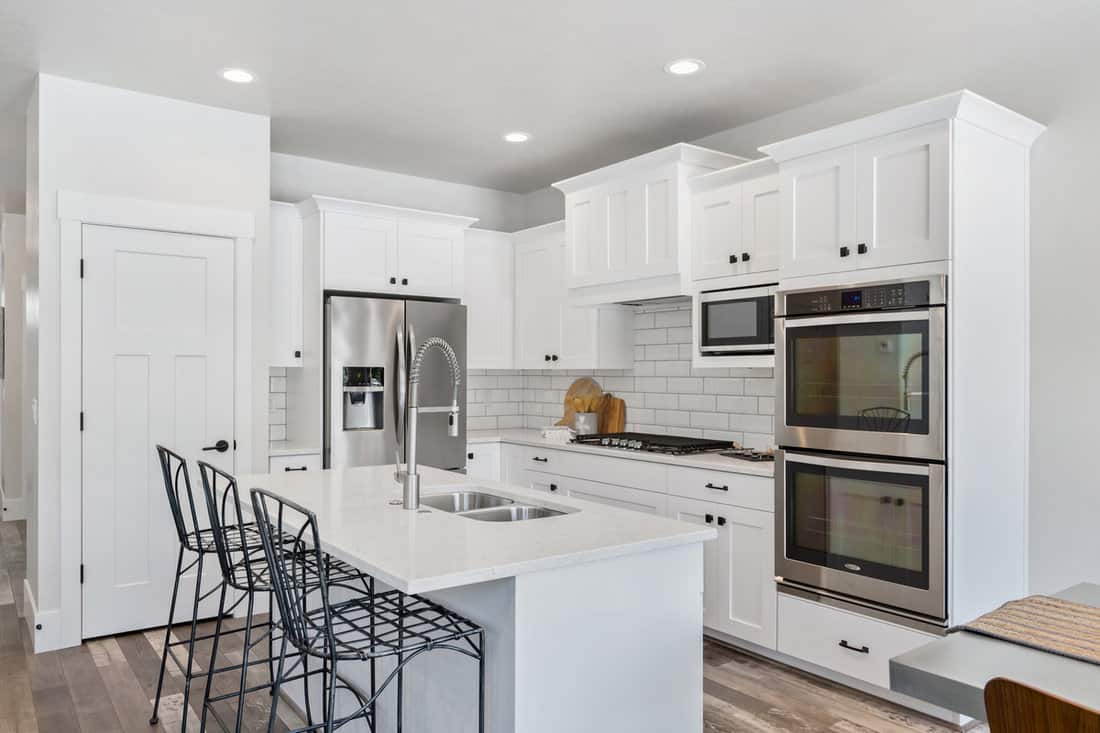
Although breakfast bars and kitchen islands have the same basic design, there are two differences between a kitchen island and a breakfast bar.
The main difference is the overhang of the countertop. Instead of the countertop ending flush with the cabinet base, it would extend off the base between 8 and 15 inches. This additional countertop space creates a comfortable place to slide a stool up and sit.
The other difference is that a breakfast bar does not have to be freestanding like an island. A seated breakfast bar only needs the space to pull a chair or a stool up to the counter for comfortable seating. This can be accomplished by extending off of a standard countertop, should space allow.
Combination Island/Breakfast Bar
While there are many different designs for a kitchen island, there are even more designs for breakfast bars. This is because frequently, kitchen islands and breakfast bars are one and the same. You may have heard these terms used interchangeably, actually.
There are a few different ways that the designs work to favor the conjunction between the kitchen island and breakfast bar. A standard kitchen island is 36 inches in height, which should match the standard kitchen counter height. A breakfast bar can range in height depending on the type of seating you want to use. To accommodate tall bar stools, breakfast bars can be up to 42 inches in height.
Surprisingly, even if you wish to have a different height for your breakfast bar, you can still have a combination feature. While it is true that it is prevalent to find a kitchen island with one end to allow for seating, it is becoming almost as common to find a split level island.
A split level island will give you the proper height (36 inches) in the area, which is meant to be used as a workspace. It will then have a raised area (up to 42 inches) that bar stools can easily slide under.
Other Combination Variations
There can be even further confusion when you add in the mix that breakfast bars can extend off of any part of your kitchen. While they can be as tall as 42 inches to accommodate tall barstools, they can also be as low as a common dinner table (between 28 and 30 inches tall) to accommodate standard table seating.
Breakfast bars also do not have to attach to, extend from, or otherwise be part of any other kitchen feature. They can be freestanding and containing no other features, store-bought, built-in, part of a countertop, or part of a kitchen island.
Click here to see this breakfast bar on Amazon!
Is A Kitchen Island Higher Than A Counter?
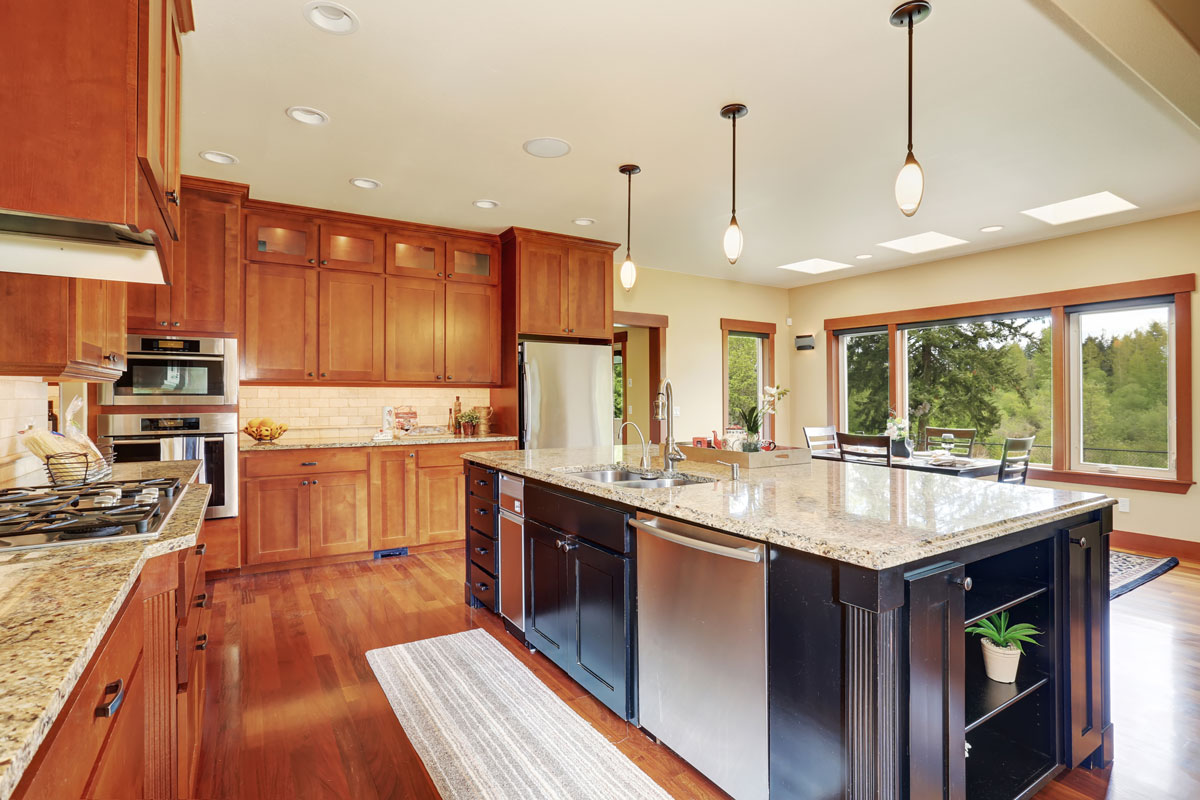
A standard kitchen counter height is 36 inches. A standard kitchen island will range from 36 inches to 42 inches in height. Sometimes, a kitchen is designed to incorporate an eat-in kitchen feature; this feature often seconds as a kitchen island. In these kinds of situations, you'd be more likely to find a kitchen island that is 36 inches in one area (generally the area designed to be used as a kitchen island) and 42 inches in another area (which would be the area designed for sitting to dine at).
What Is The Best Top For A Kitchen Island?
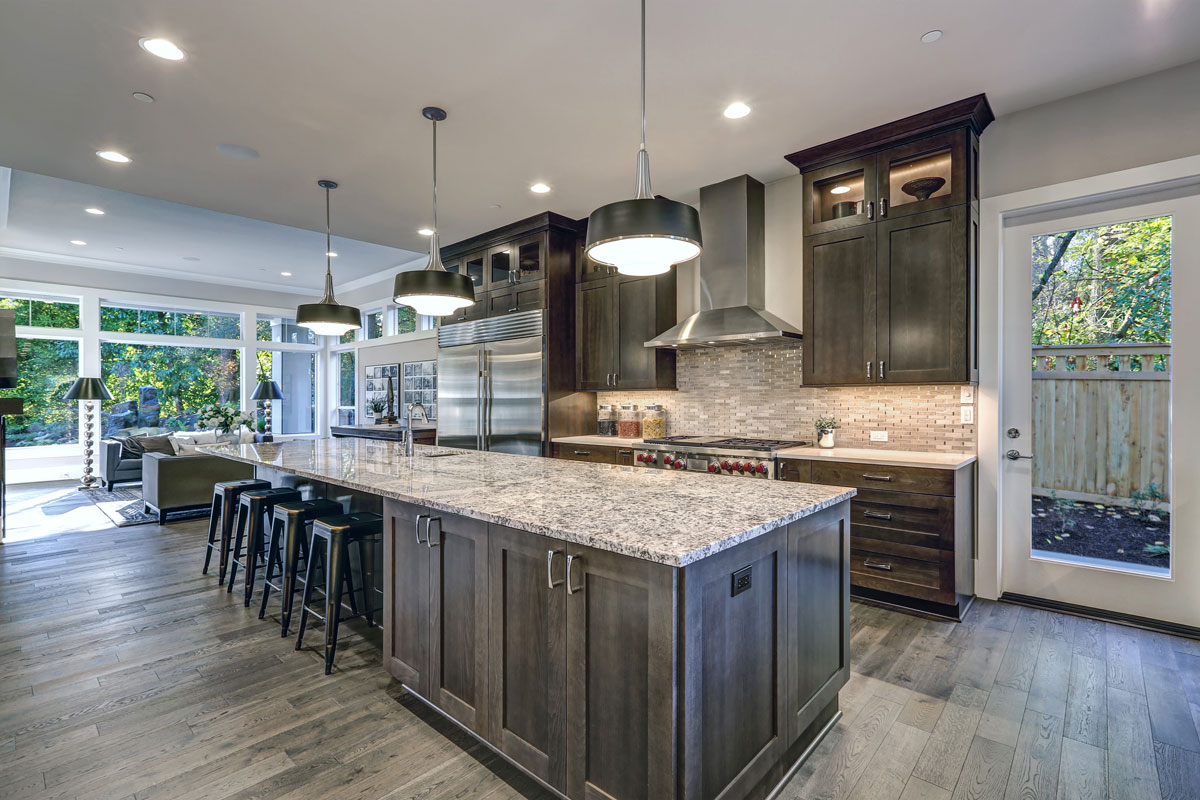
There are various materials and styles that are used for the countertop on a kitchen island. The most common are granite, butcher block, concrete, stainless steel, and laminate. These materials have both downsides and benefits. Since there are many options to choose from, it's best to first consider your island's most important functions.
For example, if the island's purpose is to expand your preparation space, you may consider using a butcher's block for the countertop. This is because of the durability of butcher blocks. They can hold up under the frequent stress of being used, chopped on, and cleaned.
On the contrary, some people like the aesthetic appeal that a kitchen island offers as they walk into the room. In this case, you may be more inclined to go with something a little flashier or something that matches closely to the rest of your countertops.
It is important to note that island countertops do not have to match all other countertops in the kitchen. You can introduce different colors and textures to create more definition between the two different spaces.
How Much Should A Breakfast Bar Overhang?
To give enough space to sit comfortably, a breakfast bar should overhang between 8 and 15 inches. You can read more on the details surrounding how far of an overhang to plan for by checking out our article: How Much Should A Breakfast Bar Overhang?
Does A Kitchen Island Add Value?
In many cases, it absolutely does. Of course, this is not always true, because like everything else, this answer will heavily depend on your unique situation and the workable space in your kitchen.
Sometimes a kitchen island can add much-needed countertop space and the ever-coveted storage space. Other times, the island can be that one element that makes your kitchen feel extremely overfilled.
Since all this is the case, the best course of action is to make sure you take all of the specific elements into consideration before deciding to add a kitchen island just for the sake of adding a kitchen island.
You'll want to be sure to make any walk aisles in your kitchen at least 36 inches wide or more. Ideally, you'd want to leave between 42 and 51 inches to allow for those extra unaccounted for situations (such as a large fridge door or other people walking around your kitchen at the same time). You should also be sure to leave clear access to your kitchen's major components: stove, sink, refrigerator. If you have enough space to do all of this comfortably, you could consider adding a kitchen island.
Value doesn't always mean money, though. You can derive value from obtaining more functionality from a space you already have. Check out our article How to Separate the Kitchen and Dining Room [and How to Combine Them Too!] to help increase the functionality of difficult spaces.
Are Kitchen Islands Going Out Of Style?
While there are a few designers that dislike kitchen islands as a whole, according to the Wall Street Journal, a kitchen island is the 2nd most sought after kitchen feature. This kitchen feature only comes after the extremely coveted pantry cabinet. Despite the few anti-open-concept designers' protests, kitchen island features are steadily holding their popularity among home buyers and renovators.
In closing

Determining whether to choose a kitchen island or breakfast bar will be largely determined by your needs. What space you have available, the needs you have to satisfy, and your available resources will help you choose. Rest assured that islands won't be out of style anytime soon, but that doesn't mean you should add one just for the sake of adding one either. Use the resources we provided above to help you make the right decision!
If you've already decided on a kitchen island, check out our article How to Decorate a Kitchen Island the Right Way!



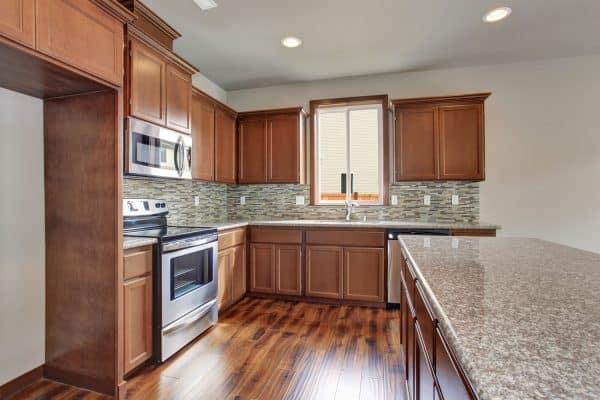
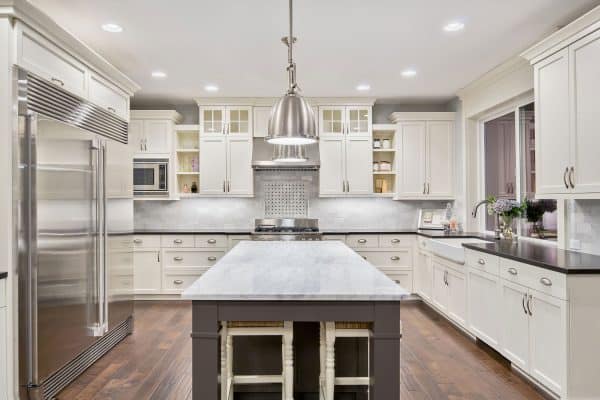
![Beautiful Kitchen in New Luxury Home with Refrigerator, Oven, Hardwood Floors, Kitchen Island, and Pendant Lights, Is Granite Cheaper Than Quartz? [Which Is Better?]](https://homedecorbliss.com/wp-content/uploads/2022/12/Beautiful-Kitchen-in-New-Luxury-Home-with-Refrigerator-Oven-Hardwood-Floors-Kitchen-Island-and-Pendant-Lights-600x400.jpg)